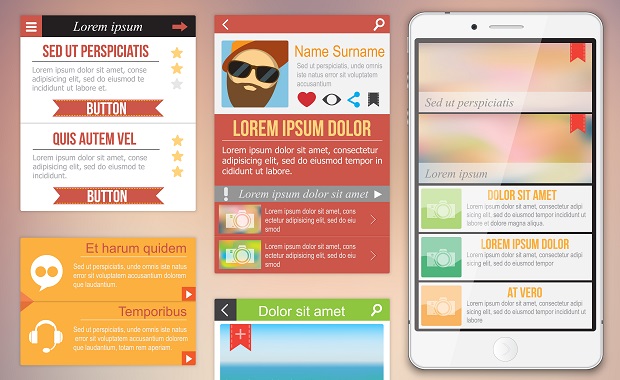Since the human race came into existence, there has been a strategy for almost everything. Strategy to survive, strategy to catch a game, arrange clean drinking water, rage wars over the enemies, strategies to overthrow the empires, strategies to win lady’s heart ;), strategies to get your ex-boyfriend back 😛 and what not.
Advancement of technology and Strategic Planning have transformed the businesses of today. A portable, hand-held mobile device is used for communicating across 7 seas. It is used as a medium of entertainment and as a tool to advertise, plan and monitor the business. According to a report from eMarketer, the number of smartphone users will surpass 2 billion mark worldwide in 2016. With the exponential increase in the number of users accessing the information through smartphones, tablets, and other digital devices; undeniably, the ‘future of web belongs to mobile’ and mobile apps.
But it all depends on your app design
Great design is capable of making your application a big hit or a long lost forgettable name in the ocean of millions and billions of apps present in the app store. A beautiful and feature loaded application software is worth the user’s time and choice. With the clarity that you want an app for your product and having done the thorough in-depth analysis of the target user base, the next important step on your app building journey is – Design Process.
“Design is a funny word. Some people think design means how it looks. But of course, if you dig deeper, it’s really how it works.” – Steve Jobs
Mobile App UX Design Strategies are essential, but where to look for them?
The design team is not only responsible for UX design process but also for the communications between the product and its users. Therefore, whether you are providing the information or entertaining your end users, a well-planned and properly implemented design strategy is essential for a great Mobile App UX Design.
Here, we want to uncover various strategies that can work well for Mobile App UX Design and let you achieve UX Design stardom.
Pleasing User Interface (UI) design
“A user interface is like a joke. If you have to explain it, it’s not that good.” – Martin LeBlanc

UI or User Interface is one of the key factors that will make your Mobile App UX shine. Your UI includes everything, right from the virtual keyboard to varied screen size which your target device employs. Several mobile platforms including Android and iOS are involved in releasing the updates that dramatically alter the UI designs, thereby impacting the use of the app by their respective users. Developers closely follow these updates, make use of latest UX design tools, UX design patterns and take advantage by developing the apps by imbibing new features.
Selection of Color, The Psychological Perspective
We all love colors, don’t we? With much awaiting eyes, we wait for Holi – Festival of colors. Colour has a deep effect on human body, mind, and soul. Science behind it 🙂
Choice of colors has a huge impact on the modern day branding, web design, packaging, fashion, product, interior design and mobile UX design too. Use of colors has a deep impact on a number of mobile application factors like look and feel,conversion rates as many colors instill a tendency to take actions.
Just like in a real world, colors can arouse certain feelings and can make people react in a specific way. Colors like green and red, if used in call-to-action (CTA) buttons offer highest ranks in conversions. For instance, Chinese make use of very bright colors in their mobile app. Use of red and green is highly prevalent on their website as it promotes good luck and happiness, what’s better than a happy customer?
Nominal UI design, Presentation at par with User Expectation
By the time you have reached this point, you are very well aware of the importance of a pleasing UI design. But that’s not enough. Ever heard a phrase “Excess of anything is bad”. This goes ideal for the UI design as well.
Using Minimal UI design is been in trend for quite some time now. As mobile apps are required to be super functional, it’s not only about best UX design, an app should be able to apply a number of processes altogether like registration, in-app purchase, etc. The key proposition to this approach is to offer the user what they want to know. It is considered as the easier way to propose your app to the user. Besides, it also lessens the burden of information which the user is required to memorize, thereby providing an exceptional mobile user experience.
Minimal UI designs can be applied to the checkout processes and registration screens. At checkout processes, use of minimal UI doesn’t confuse and frustrate the customer with unneeded information. Registration screens, where just data collection from users is the need, avoiding excessive text field will avoid clutter and assist in increased sign-ups.
Amazing Mobile Onboarding Experience
Displaying Onboarding screens or Walkthroughs is a common practice. Its purpose is to introduce the app and demonstrate what it does.

Delivering a high quality, onboarding experience is a key factor for attracting new and retaining old users. Onboarding should be considered an entry ramp for app highway, with varied screens being the scenery. The main objective of onboarding is to let user achieve what they want efficiently and quickly. By the means of progressive onboarding, the user can be provided with the instructions to use the app. If you have a mobile app, devoid of an intricate flow, hidden formalities, gesture-driven interactions, or multiple sections, progressive onboarding is a great choice.
Transmutation from Customized to the Personalized UX
When you are tailoring an app to get it just right, you are customizing it. But when an app adapts itself on the basis of knowledge it already has about you, with minimal or no effort, that’s Personalization.
Before the advent of mobile communication, desktop sites utilized cookies to personalize the home screen based on past visits. Later, when mobiles were used for browsing, the engineers migrated this technology to mobile, but with a wide range of screen sizes, it was a tough job. Then came ‘Personalization’, where past behavior was well recorded and stored by an app. Personalization is one of the countless ways to improve a Mobile App UX Design. For example, if your users prefer purchasing a certain product for themselves at the start of every month, a personalized app with special deals and product offerings, special deals, discount coupons, personal recommendations, etc. can ultimately help you enhance the revenue.
Gesturization, A Clever Gesture is More than an Action
You must have seen many websites using scrolling, swiping and pinching, these all are examples of Gesturization. Earlier the UI of some of the best apps were restricted to minimum functionalities like pinching and swiping. Now, the designers have come up with more focus on multiple gestures like UI designs. For example, swipe gestures facilitate share and delete actions.

Market study is as important as setting up gestures in your app. It is important what gestures is your target audience using, you can employ similar gestures in your app. By doing this exercise, you are optimizing your UI as per your audience’s behavior. Your users will feel comfortable and it is much easier for them to use your website.
Analyzing Mobile UX, Use of Qualitative Data
Daily monitoring of Mobile app’s UX is a must. App developers should use analytics software to dig deeper into the user behavior based on the qualitative data and key metrics. Observations that are identified from the analysis will assist developers to refine your app which will further assist in UX optimization.
About the Author
Ankur Kumar is an experienced blogger and likes to write on various topics including technology, digital marketing, and environment. He is an active member of various programming forums for tech knowledge enhancement.
